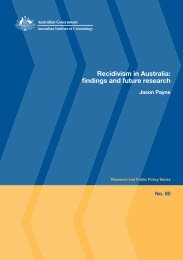Review of anti-corruption strategies Rob McCusker - Australian ...
Review of anti-corruption strategies Rob McCusker - Australian ...
Review of anti-corruption strategies Rob McCusker - Australian ...
Create successful ePaper yourself
Turn your PDF publications into a flip-book with our unique Google optimized e-Paper software.
Asian Development Bank, Organisation for Economic Co-operation and Development and Transparency<br />
International 2005. Curbing <strong>corruption</strong> in tsunami relief operations. Manila: Asian Development Bank.<br />
http://www.adb.org/Documents/Books/Curbing-Corruption-Tsunami-Relief/curbing-<strong>corruption</strong>-tsunamirelief.pdf<br />
This paper outlines lessons relevant to humanitarian relief and reconstruction efforts concluded at the<br />
Expert Meeting on Corruption Prevention in Tsunami Relief (April 2005, Jakarta) jointly convened by the<br />
Asian Development Bank / Organization for Economic Co-operation and Development Anti-Corruption<br />
Initiative for Asia–Pacific, and Transparency International.<br />
Asia–Pacific Economic Cooperation 2005. APEC Anti-Corruption and Transparency Symposium,<br />
1–2 September 2005<br />
This paper details the nature <strong>of</strong> the aforementioned symposium and notes that it produced a number <strong>of</strong><br />
relevant strategy papers including ones concerned with eliminating bribery and <strong>corruption</strong> in business<br />
transactions and ensuring integrity in the public sector.<br />
<strong>Australian</strong> Agency for International Development 2005. Ringing the church bell: the role <strong>of</strong> churches in<br />
governance and public performances in Papua New Guinea. Canberra: AusAID<br />
This paper discusses a case study which examines the role <strong>of</strong> the Christian churches as institutional<br />
actors within Papua New Guinea’s governance and service delivery landscape.<br />
Babb J 2005. Corruption and governance in Japan, in Hook G (ed), Contested governance in Japan:<br />
sites and issues. New York: RoutledgeCurzon: 174–191<br />
This chapter suggests that it is best to try to look at the manner in which the Japanese themselves have<br />
constructed their political understanding <strong>of</strong> and attempts to cope with <strong>corruption</strong>. In doing so, the political<br />
must be highlighted as a contrast to fixed notions <strong>of</strong> culture and/or ‘good governance’. In the end, it is<br />
possible that the changing nature <strong>of</strong> political <strong>corruption</strong> may be as much a part <strong>of</strong> Japanese governance<br />
as the attempts to eliminate it.<br />
Brown AJ 2005. Chaos or coherence? Strengths, opportunities and challenges for Australia’s integrity<br />
systems: final report. Brisbane: Griffith University and Transparency International<br />
This paper deals with a range <strong>of</strong> new methodological issues in developing a new approach to integrity<br />
system assessment for Australia and potential application elsewhere. These include: how integrity<br />
should be defined; how relevant integrity institutions should be identified (including as ‘core’ or primary<br />
institutions; ‘distributed’ or dispersed <strong>strategies</strong>); and how the many institutional and non-institutional<br />
elements <strong>of</strong> an integrity system should be described. The assessment resulted in a useful new, natural<br />
metaphor – a bird’s nest, in which a multiplicity <strong>of</strong> small elements make up the system, <strong>of</strong>ten individually<br />
weak, but clearly interdependent and stronger as a whole.<br />
Brown AJ & Head B 2005. Institutional capacity and choice in Australia’s integrity systems. <strong>Australian</strong><br />
journal <strong>of</strong> public administration 64(2): 84–95<br />
This paper examines recent debate over core or ‘independent’ integrity institutions in the Victorian and<br />
Commonwealth governments to highlight some <strong>of</strong> the need, and potential, for more careful deliberation<br />
over options for building the capacity <strong>of</strong> integrity systems – the second <strong>of</strong> the analytical themes used in<br />
Australia’s national assessment. The first part compares the resourcing <strong>of</strong> major integrity institutions by<br />
<strong>Australian</strong> governments over the past 15 years. Staffing and finances are seen as a useful basic measure <strong>of</strong><br />
capacity, helping lift attention away from the assumption that creation <strong>of</strong> new bodies necessarily increases<br />
capacity. The data also show that some jurisdictions – including Victoria – may yet have some way to go<br />
if they wish to match other governments. The second part <strong>of</strong> the analysis identifies eight further issues for<br />
consideration in deliberations on institutional design. The paper concludes that by working through such<br />
issues more systematically, it may be possible to identify new or different institutional options for configuring<br />
integrity resources. This could help avoid inappropriate choices – whether unnecessary new bodies,















